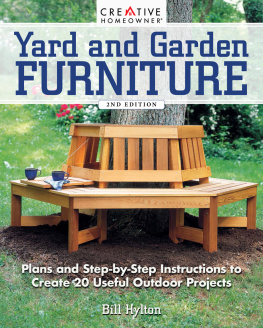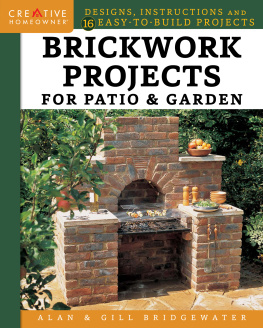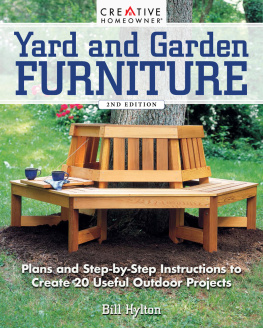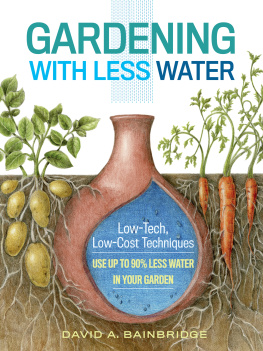CONCRETE GARDEN PROJECTS


CONCRETE
Garden Projects
EASY & INEXPENSIVE
CONTAINERS, FURNITURE,
WATER FEATURES
& MORE
Malin Nilsson
Camilla Arvidsson

For our children
August
Jack
Kalle
Ellen
Text copyright Malin Nilsson and Camilla Arvidsson
Photographs copyright Camilla Arvidsson except author
photograph on page 7 Gabriella Dahlman
Originally published as Vattenblnk & Betong
2010 Ica Bokfrlag, Forma Books AB. All rights reserved.
This edition published in 2011 Timber Press, Inc.
The Haseltine Building
133 S.W. Second Avenue, Suite 450
Portland, Oregon 97204-3527
www.timberpress.com
2 The Quadrant
135 Salusbury Road
London NW6 6RJ
www.timberpress.co.uk
ISBN-13: 978-1-60469-282-2
Printed in China
Catalogue records for this book are available from the Library of Congress and the British Library.
Contents
Hooray for concrete!
Concrete is a magical material that can produce sober, heavy-weight pots one minute and delicate, fragile leaf prints the next. More and more people are discovering what a fantastic material concrete can be in the garden, with rough concrete providing an excellent foil for greenery. Water is another great complement to it, whether it be as a birdbath sunk into a dazzling flowerbed, or a small pond complete with a trickling fountain. On the other hand, weathering by the wind and rain imbues it with a dignified, aged look and encourages moss to develop, making the object even more beautiful.
We have been using concrete as a medium for years, but are still constantly surprised by its potential, which often gives rise to new ideas. This book is a collection of our favourite projects, large and small: pots, birdbaths, tealight holders, stepping stones, a barbecue-cum-outdoor-kitchen, and much, much more. We have also chosen to include in the book inspirational images of finished concrete objects in our own gardens.
Once you have selected a project, follow the detailed, step-by-step instructions provided in the project handbook at the back of the book. We hope that those of you who have worked with concrete before will find something new to try and that newcomers will be inspired to give it a goits really not as difficult as you might think. Good luck!

Numbers show the way
There are a variety of moulds you can use to create attractive house numbers. Our preferred one for this project is a number from a giant foam floor puzzle. These are available in a variety of sizes from most toy shops. Puzzle pieces like this make great moulds, and the end results are consistent and attractive.
Styrofoam is an ideal alternative if you want to make your own number templates. As styrofoam is available in various thicknesses, you can make the number as big and/or thick as you like. A similar template could also be used to stamp the number down into a square of wet concrete.
You can also take this project a step further by decorating the number with some pretty pebbles or mosaic tiles. Or why not paint it? Dots could be fun!
This concrete number has been hung on a gate using a nail.
 Full instructions on page .
Full instructions on page .

Come on in!
Whether you work or play in the garden, a shoe scraper is great for getting mud off shoes and makes an attractive feature in itself. Use pieces of triangular moulding that have been nailed to a sheet of plywood to create the raised edges.
Concrete scrapers are durable and weatherproof. Any mud and dirt on them will be washed off by the rain, but they will also withstand a once-over with the hose if necessary.
Make your home more inviting by arranging plants in a variety of pots on your steps, like the miniature rose, thyme and common box seen here. A good tip is to always keep some winter greenery to hand so that it can be supplemented with seasonal blooms to give a warm welcome all year round. If your steps have railings, you could also try winding some evergreen ivy around them.
This shoe scraper has been laid in gravel at the foot of some steps.
 Full instructions on page .
Full instructions on page .


Timeless pots
Concrete pots are beautiful all year round. They look fantastic planted with geraniums in summer, asters in autumn and Christmas roses in winter. That said, its hard to beat a display of potted spring bulbs. If you buy forced ones, you can even enjoy some early spring colour.
One of the easiestand prettiestthings you can make out of concrete is a small pot. Gently rounded, straight-sided or even star-shapedyou decide. Kitchen containers and plastic pots make excellent moulds. Plastic bottles are handy for making the hollow inside the pot. Make each pot unique by varying the thickness of the walls and the shape of the inside of the pot. A square pot can have a round inside and vice versa. Re member that the pots do not all need to be the same heightones that are short and wide mixed with ones that are tall and thin will make an attractive display.
Set a spring table with pots of different shapes and sizes. This concrete tabletop is resting on an old wrought-iron table.
 Full instructions on pages .
Full instructions on pages .

During the construction process, you can make one or more drainage holes in the base of the pot using a cork or piece of styrofoam to allow any excess water to drain away. For pots without holes, put a layer of clay balls in the bottom before filling the pot with compost to help absorb excess water and to combat root rot.
Then gather together a number of different pots or choose one in which to plant your favourite flowers. Set a spring table that is pleasing to the eye, with sky-blue grape hyacinths, scented hyacinths, crocus buds and elegant Christmas roses with their long-lasting blooms. Nothing beats the first show of spring colour.
Next page













 Full instructions on page .
Full instructions on page .


